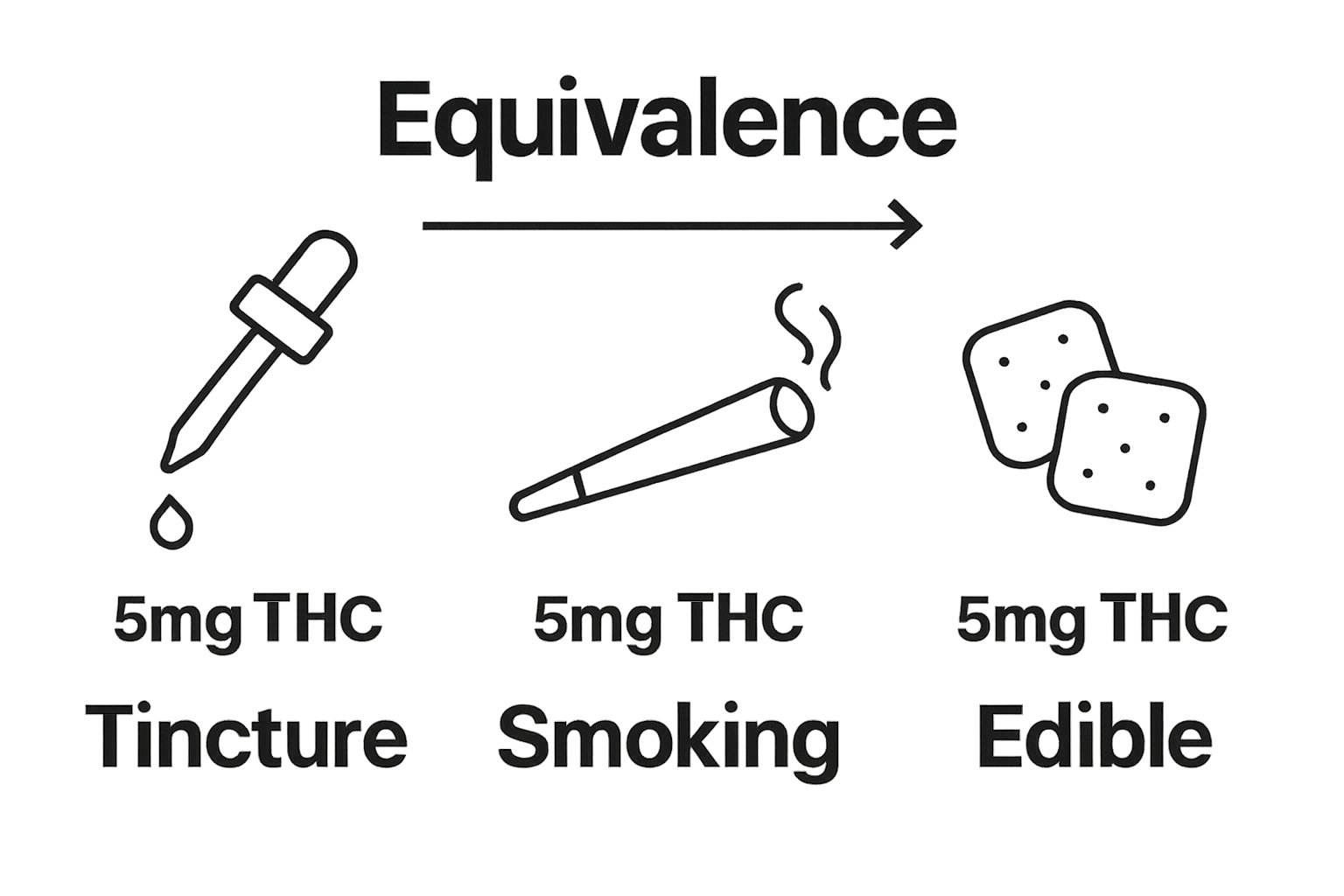Blog
Understanding What is a Dosage Guide for Cannabis Use
Figuring out how much cannabis to use is more than guesswork. A standard cannabis dose is now measured as just 5 mg of THC, giving everyone a clear starting line. That sounds simple enough, but having a number is not the whole story. What actually matters is how wildly people’s bodies react to those milligrams—and why a guide meant to keep you safe can mean something totally different for you than for your friend.
Table of Contents
- Defining A Dosage Guide: What Is It?
- The Importance Of Dosage In Cannabis Consumption
- How Dosage Guides Operate: Understanding Measurements
- Key Concepts: Tolerance, Potency, And Individual Needs
- Real-World Applications: Using A Dosage Guide Effectively
Quick Summary
| Takeaway | Explanation |
|---|---|
| Understanding dosage guides is essential. | Dosage guides provide structured recommendations for safe cannabis consumption tailored to individual needs. |
| Personalized dosing prevents overconsumption. | Adjusting doses based on personal tolerance minimizes adverse effects and enhances the experience. |
| Standardized measurements improve clarity. | Consistent THC milligram baselines help users effectively compare different consumption methods and types. |
| Monitor reactions to refine dosage. | Regularly tracking responses to cannabis can inform adjustments for individualized dosing strategies, enhancing safety and effectiveness. |
| Consult professionals for medical use. | Engaging healthcare providers ensures that cannabis dosages are safe and appropriate, particularly for medical users. |
Defining a Dosage Guide: What Is It?
A dosage guide represents a structured framework that helps individuals understand appropriate consumption levels for cannabis products, ensuring safe and controlled usage. Unlike generic recommendations, these guides provide personalized insights into recommended intake based on multiple critical factors.
Understanding Cannabis Dosage Fundamentals
A dosage guide is essentially a comprehensive reference that maps out precise cannabis consumption recommendations. According to Addiction Research Journal, standardizing cannabis consumption involves establishing a consistent measurement unit, typically 5 mg of THC as a baseline reference point for various product types.
Key components of an effective dosage guide typically include:
- Individual physiological factors
- Product potency and cannabinoid composition
- Method of consumption
- Intended therapeutic or recreational purpose
- Personal tolerance levels
Importance of Personalized Dosage Recommendations
Customizing cannabis dosage is not a one-size-fits-all approach. Medical professionals and cannabis experts emphasize the significance of personalized guidance. Clinical Cannabis Research Center recommends a systematic approach to determining appropriate dosages, which involves gradual titration and careful monitoring.
For new consumers, starting with minimal doses and incrementally adjusting allows for understanding individual response and minimizing potential adverse reactions. Precise dosage guidelines help prevent overconsumption and ensure a controlled, predictable cannabis experience.
By providing clear, scientifically-informed recommendations, dosage guides empower users to make informed decisions about their cannabis consumption, balancing potential benefits with responsible usage.
The Importance of Dosage in Cannabis Consumption
Dosage management is a critical aspect of responsible cannabis consumption that significantly impacts user safety, experience, and potential therapeutic outcomes. Understanding the nuanced relationship between intake levels and individual physiological responses is fundamental to maximizing cannabis benefits while minimizing potential risks.
Health and Safety Considerations
Proper dosage control is essential for preventing adverse health effects. National Institute on Drug Abuse research highlights that inappropriate cannabis consumption can lead to significant health complications. The risks associated with improper dosing include:
Below is a comparison table detailing health and safety risks associated with improper cannabis dosing, as highlighted in the article.
| Risk/Effect | Description |
|---|---|
| Increased anxiety | Heightened psychological distress or panic |
| Cognitive impairment | Reduced memory, attention, and decision-making abilities |
| Disrupted motor function | Impaired coordination, affecting driving and physical tasks |
| Negative side effects | Unwanted outcomes such as nausea or dizziness |
| Potential long-term neurological impacts | Possible lasting changes to brain function and health |
- Increased anxiety and psychological distress
- Potential cognitive impairment
- Disrupted motor function
- Higher likelihood of experiencing negative side effects
- Potential long-term neurological impacts
Therapeutic and Recreational Balance
For both medicinal and recreational users, precise dosage management creates a balanced and predictable experience. Controlled consumption allows individuals to modulate their physiological and psychological responses, ensuring that cannabis serves their intended purpose without overwhelming side effects.
Research from Frontiers in Psychiatry emphasizes that individualized dosing strategies must account for multiple variables. These include product potency, consumption method, personal tolerance, and specific health objectives.
By approaching cannabis consumption with a strategic and informed dosage mindset, users can transform their experience from potentially unpredictable to carefully controlled. Dosage management becomes a crucial skill that empowers individuals to engage with cannabis responsibly, whether for therapeutic relief or recreational enjoyment.
How Dosage Guides Operate: Understanding Measurements
Dosage guides transform complex cannabis consumption into a systematic and measurable approach, providing users with precise frameworks for understanding and controlling their intake. These guides translate abstract consumption recommendations into tangible, actionable measurements across different product types and consumption methods.
Standardizing Cannabis Measurements
Measurement standardization is crucial for creating reliable dosage guidance. Cornell Health recommends specific baseline approaches for different consumption methods, emphasizing the importance of incremental and careful dosing.
Key measurement principles include:
- Establishing a consistent THC milligram baseline
- Tracking consumption method variations
- Understanding individual tolerance levels
- Monitoring onset and duration of effects
- Recognizing product-specific potency differences
Comparative Dosage Equivalencies
Dosage guides help users understand how different consumption methods relate to each other. The Index of Cannabis Equivalence provides critical insights into translating dosages across various product types. For instance, two puffs from a joint might equivalently represent a 5 mg THC edible, allowing users to make informed comparisons.

By creating standardized measurement frameworks, dosage guides empower consumers to make educated decisions about their cannabis consumption. These guides serve as critical tools for managing intake, understanding personal limits, and promoting responsible use across therapeutic and recreational contexts.
Key Concepts: Tolerance, Potency, and Individual Needs
Cannabis consumption is a complex interplay of physiological responses, product characteristics, and personal biological factors. Understanding the intricate relationships between tolerance, potency, and individual metabolic variations is crucial for developing effective and safe consumption strategies.
Understanding Cannabis Tolerance
Tolerance represents the body’s adaptive response to repeated cannabis exposure, where an individual requires progressively larger quantities to achieve similar effects. This biological mechanism varies significantly between users and can develop through consistent consumption.
The following table summarizes key factors that influence cannabis tolerance, helping readers quickly compare how each element contributes to individual responses.
| Factor | Description |
|---|---|
| Frequency of consumption | How often cannabis is used, impacting how quickly tolerance develops |
| Individual metabolic rate | The body’s ability to process and eliminate cannabinoids, affecting onset and duration |
| Genetic predisposition | Inherited traits influencing sensitivity to cannabis and tolerance buildup |
| Body composition | Factors like weight and body fat percentage that can alter how cannabis is metabolized |
| Consumption method | The way cannabis is used (smoked, vaped, ingested), impacting absorption and effects |
Key factors influencing cannabis tolerance include:
- Frequency of consumption
- Individual metabolic rate
- Genetic predisposition
- Body composition
- Consumption method
Potency and Personal Variability
Potency measurements provide critical insights into a product’s potential impact. Journal of Cannabis Research emphasizes that cannabinoid concentration directly correlates with potential physiological and psychological effects.
Individualized responses to cannabis potency depend on multiple interconnected biological factors. Each person’s endocannabinoid system processes cannabinoids uniquely, making standardized dosing recommendations challenging. Factors such as body weight, metabolism, prior cannabis experience, and overall health significantly influence how an individual responds to different potency levels.
By recognizing the complex interactions between tolerance, potency, and personal biochemistry, consumers can develop more nuanced and personalized approaches to cannabis consumption, prioritizing safety and desired outcomes.
Real-World Applications: Using a Dosage Guide Effectively
Dosage guides transform theoretical knowledge into practical cannabis consumption strategies, bridging the gap between scientific understanding and individual user experiences. Implementing these guidelines requires a systematic and mindful approach that prioritizes personal safety and desired therapeutic or recreational outcomes.
Medical Cannabis Treatment Strategies
National Center for Cannabis Research recommends a collaborative approach to determining appropriate cannabis dosages. Medical professionals play a crucial role in guiding patients through personalized dosing protocols.
Key considerations for medical cannabis dosing include:
- Consulting with qualified healthcare providers
- Documenting individual response and side effects
- Starting with lowest effective doses
- Monitoring long-term treatment outcomes
- Adjusting dosage based on specific medical conditions
Tracking and Adapting Dosage Patterns
Effective dosage management is an iterative process that requires ongoing attention and self-awareness. Research indicates that cannabis consumption patterns can evolve significantly over time, with users developing nuanced approaches to their intake.
Personal record-keeping becomes a critical component of responsible cannabis use. By tracking factors such as product type, dosage, consumption method, and subsequent physiological and psychological responses, individuals can develop increasingly precise and personalized consumption strategies.
Ultimately, a dosage guide serves as a dynamic framework that empowers users to make informed, safe, and intentional decisions about their cannabis consumption, recognizing that individual needs and responses are constantly evolving.

Take Control of Your Cannabis Dosage With Verified Products and Expert Guidance
Struggling to find the right cannabis dosage for your unique needs can be overwhelming, especially when faced with questions about potency, tolerance, and method of consumption. You want accuracy and safety, whether you are a new or experienced user. The article explained how a reliable dosage guide is crucial for avoiding unwanted effects and making sure you reach your wellness or recreational goals. But finding trustworthy products that match these personalized guidelines is just as important for your peace of mind.
.png)
Discover how Puff Laco empowers you to follow scientifically informed dosage recommendations with confidence. Each of our premium vapes, disposables, and edibles is backed by rigorous quality and authenticity verification. With clear usage guides and real customer feedback on every product, you can easily match your personal dosage requirements to our lab-tested options. Start exploring our selection and get exclusive fast shipping and promotional offers. Visit Puff Laco’s homepage now and enjoy a cannabis experience that puts your safety and satisfaction first.
Frequently Asked Questions
What is a dosage guide for cannabis?
A dosage guide for cannabis is a structured framework that provides personalized recommendations for safe and effective consumption levels based on factors such as individual tolerance, product potency, and preferred method of consumption.
Why is personalized dosage important for cannabis users?
Personalized dosage is crucial because it ensures users find the right intake level that suits their unique physiological responses, minimizing the risk of adverse effects and optimizing the therapeutic or recreational benefits.
How do I determine the right cannabis dosage for me?
To determine the right cannabis dosage, consider factors such as your individual tolerance, the potency of the product, your consumption method, and your intended therapeutic or recreational effects. Start with a low dose and gradually increase it while monitoring your response.
What factors influence cannabis tolerance?
Cannabis tolerance is influenced by several factors including the frequency of consumption, individual metabolic rate, body composition, genetic predisposition, and the method of consumption.

